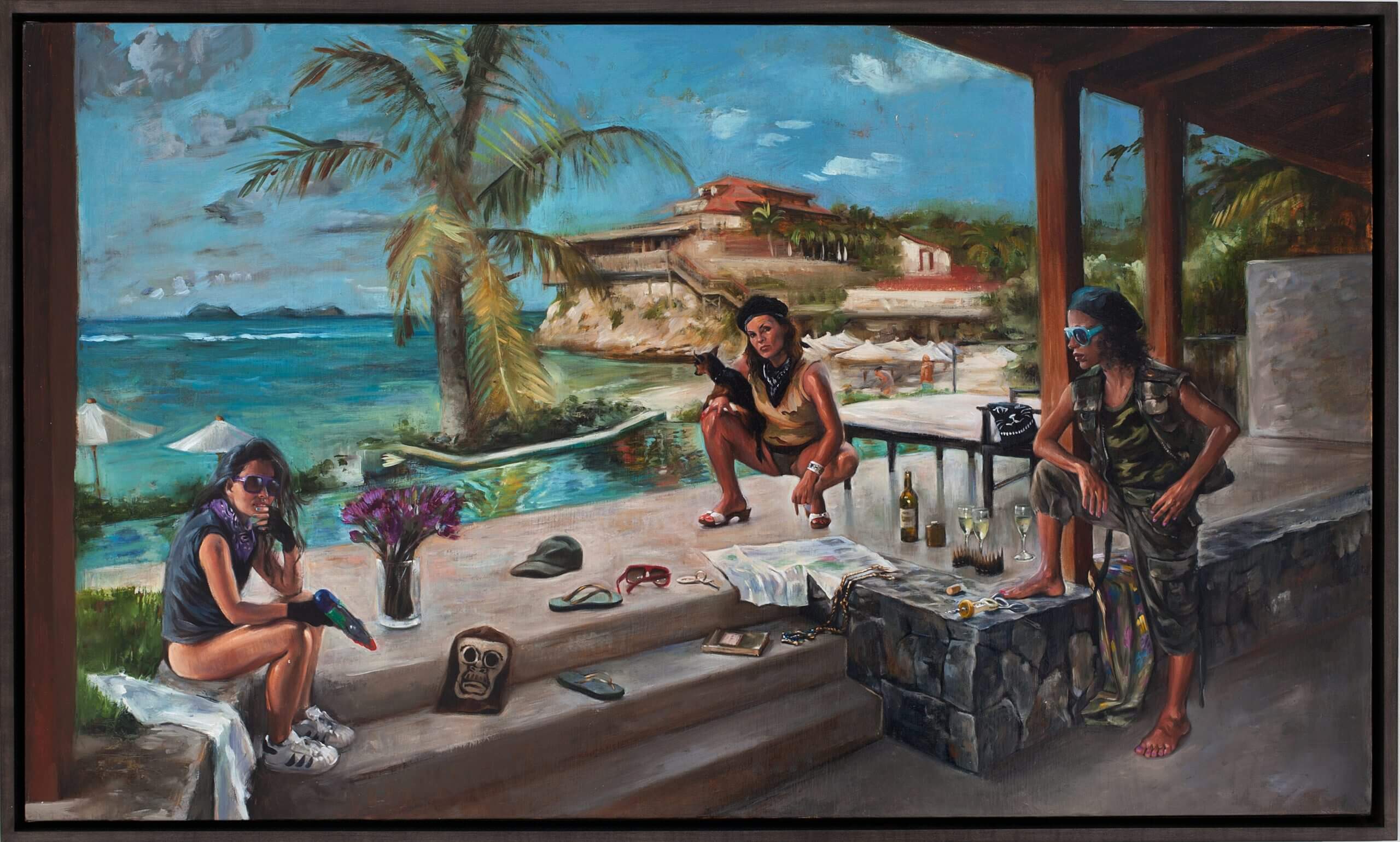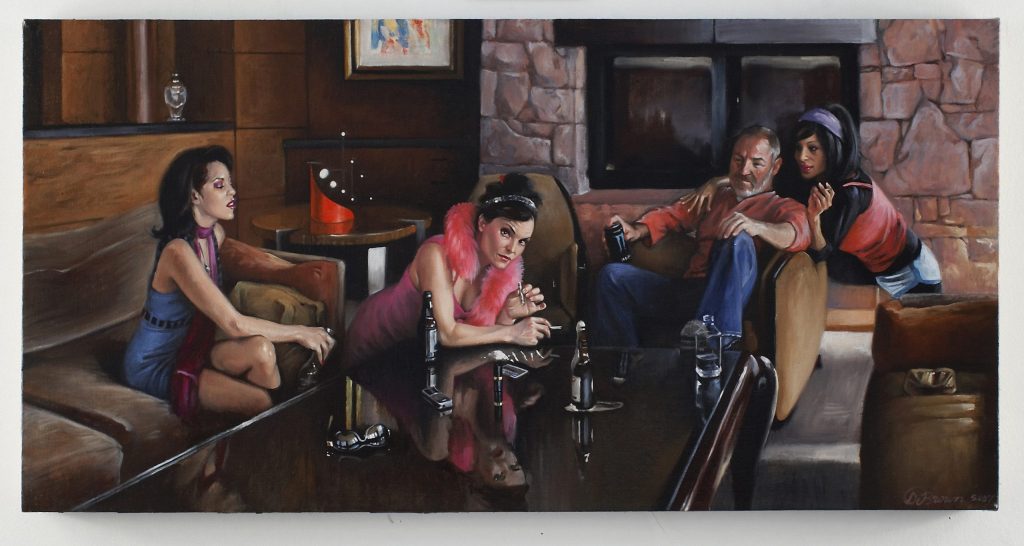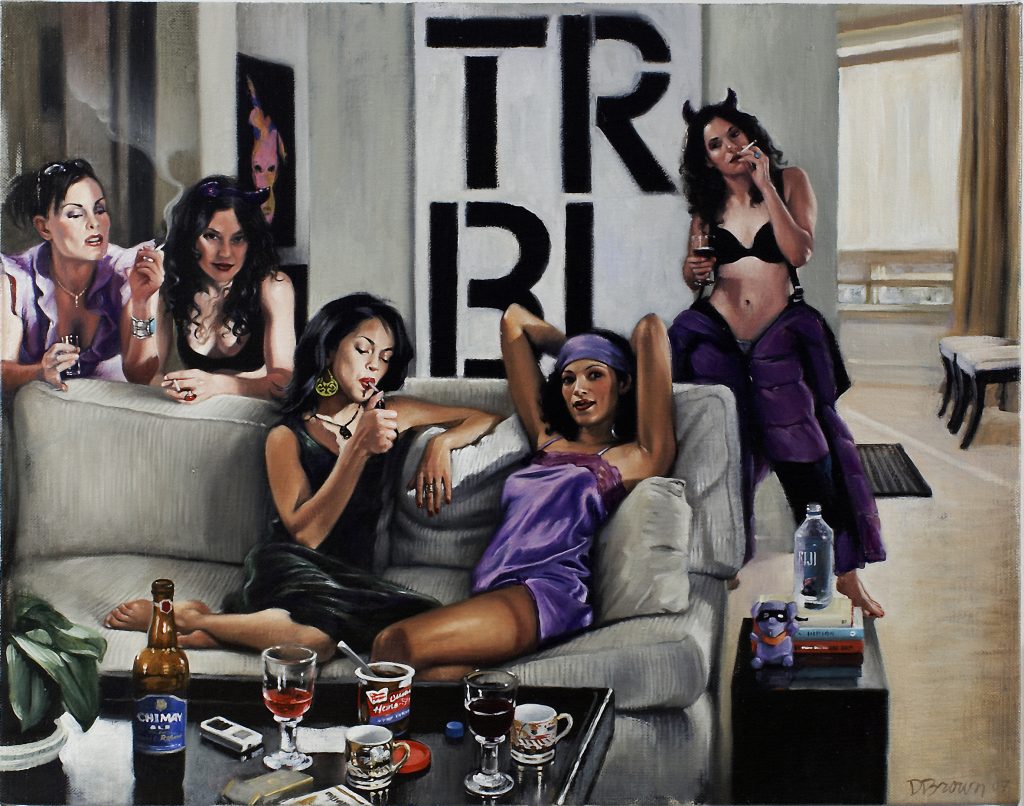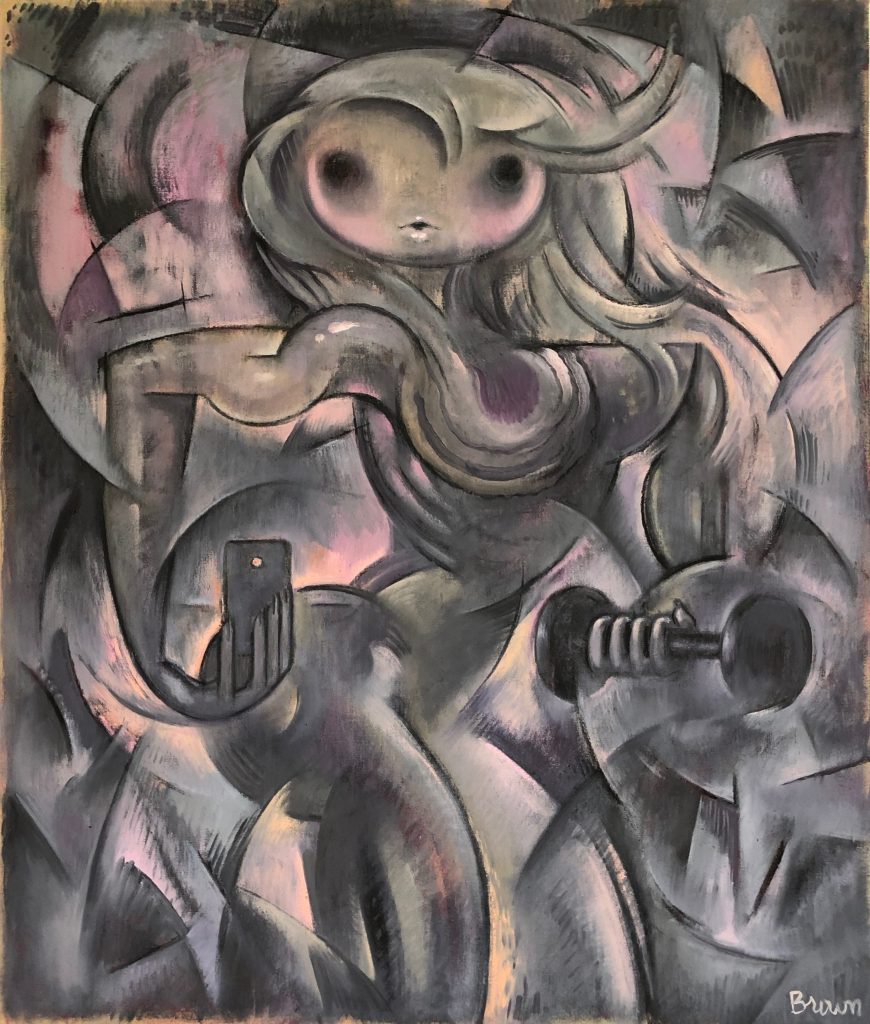Delia Brown’s Guerrilla Lounging: A New Reflection

Delia Brown is a California dreamer through and through. Born in Berkeley in 1969, she began her early studies at Goldsmith’s College (University of London) before receiving her BA in 1992 from the University of California (Santa Cruz) and her MFA from UCLA in 2000. Her best-known works, far and away, are a series of portraits of her and her friends – surreptitiously or brazenly – inhabiting and invading spaces belonging to the rich and famous. Guerrilla Lounging reached its apex when Brown and her accomplices gained access to the late Aaron Spelling’s home in Beverly Hills, in addition to being invited to an anonymous villa in St. Barth’s. Her practice has evolved, experimenting with and subverting Cubism and formal expressionism – with blushes of Anime and “kawaii” imagery – into the guises of “gym selfies” and Instagram-able pouts.
I was first introduced to Brown back in 2012, but had never met her in person (and still haven’t). Yet, we continued our exchange of ideas and correspondence and reconnected. FRONTRUNNER is pleased to present a new reflection on Brown’s Guerrilla Lounging, her successful battle with cancer, and Francisco Goya (the dog).
Right now, space is a contentious thing. We really must understand the implications of how space impacts us. Guerrilla Lounging reconsiders space, which makes it more contemporary than ever. Tell me about these works. How did this series originate?
You know, I think the idea first formed in 2002 when I was in Miami for the art fairs. The art world was still new to me, and the glamour of it all as I only started showing works in 2000. An artist friend and I were going to these parties I don’t think we were invited to. Going to a party where champagne is poured and people lounge around in an entitled way was so foreign to me. The LA I grew up and lived in was lower-middle class, and I therefore had always been enraptured by sparkle. At these parties, my friend and I would sit around on these brocade sofas and drink as much free champagne as we could. We would take pictures of each other, like “Hey, look at us!” and so I started making watercolours of us lounging around.
When I returned to LA, I realized I liked being in those sumptuous spaces. I ended up walking around some furniture showrooms in West Hollywood that were catering to the upper echelons. I met the owner of this one showroom who staged homes that were up for sale. I asked her if I could invite some friends and basically party in her showroom so that I could make paintings of them, and she said, “Absolutely!” She was very glamorous and had an amazing name like Ginger Atherton.

Guerrilla Villa (2009)
Oil on linen
22″ x 30″
Courtesy of the artist
Wow.
Yeah! She told me she made it on her own and I wanted to support other women doing it. It was like a fake-it-til-you-make-it sisterhood. One day she said, “You know, I’ve got the keys to Aaron Spelling’s house in Beverly Hills.” I’ll probably get her in big trouble for this, but this was like 20 years ago – so water under the bridge, right? I brought my girlfriends over to his giant mansion and we went from room to room playing house. I took snapshots the whole time. At the time, I just had a point-and-shoot camera. I would get the film printed and then make watercolours from them.
This was before the Paris Hilton or Kim Kardashian era, so the notion of taking up space (in a way that almost camp) was not mainstream. We took things from our wardrobes; I think I probably just went over and picked out things for my friends to wear. I would also go to the Salvation Army where I’d pile anything that sparkled into my bag. It was the poor man’s version of looking rich.

Break of Dawn (2007)
Oil on linen
12″ x 24″
Courtesy of the artist
I then took the idea of Guerrilla Lounging a little bit further in 2008 when we were invited to stay at a resort in St. Barth’s during the off-season, in exchange for a show in their gallery. I went down and invited a couple of girlfriends. In addition to bikinis and gold jewellery, I also hit up an army surplus store.An important rule: The owners of the home [had to] agree to vacate the property for at least 2 hours so that my friends and I could have the run of it without being seen by them. On occasion, the owners have ignored that stipulation, in which case I brought them in to the mise-en-scene and created a scenario that included them. In Break of Dawn, the owner of the beautiful house in Aspen also owns the main music venue/night club in town, so I decided that my friends and I would be go-go dancers and escorts who frequent the club, and that we’d all gone back to his house after-hours to do drugs.
When I first saw your work, I sensed a sort of dangerous obsession with glamour and the art world is a very sensationalist portal to that. You encapsulate this element of mainstream culture and subvert it. Was it like travelling in an alternate universe? When it was over, did you feel like you captured something beyond the image, or did you leave feeling kind of as empty as a lot of celebrities do?
Well, my really life didn’t look like that, but my work did. What I can say immediately is that I often felt a sense of nausea; for going against what my parents taught me about materialism and decadence. Also, because I’m a little bit of an addict myself. I was filling myself with so much stuff that was bad for me and I would feel like a sense of shame while doing, but I couldn’t stop, and I wanted to go bigger. Then when I was done, I felt a sense of spiritual sadness, a lot of guilt around the emptiness you mentioned. Because there is so much pleasure and decoration on the surface and then I have so much anxiety. Like, “Is it bad that I’m creating images of this? Do I feel like I’m being responsible to my values by putting these images forward in the world?” Without attaching them to a clear disclaimer, or something that says this is what you’re supposed to think when I look at these paintings.

DBL TRBL in PRDS (2007)
Oil on linen
14″ x 18″
Courtesy of the artist
When I was diagnosed with cancer, I did have to stop one project I was working on because it became so distasteful to me. Right before my diagnosis (oh God, this was so embarrassing, but) I had been watching the Real Housewives series. I couldn’t miss an episode. So I started a project where I was painting the Real Housewives, but in real life. I wanted to do was make beautiful images of them in everyday life that were contemplative. I was doing photoshoots for the Real Housewives of New York City, but when I returned back to LA, I got my diagnosis. I couldn’t watch those shows anymore. I couldn’t stomach them. So I stopped the project because this was not a place where I wanted to put my energy.
Did you retroactively feel differently about Guerrilla Lounging after that experience?
That’s a good question. I don’t think I’ve done any Guerrilla Lounging since then. I would say Real Housewives project I was working on was an extension of it – in that I was trying to insert myself into their world, but not the same. I think I’ve probably just outgrown it. I often see projects I’m working on as a way for me to get closer to some desire I have that I feel a lot of shame around. I grew up always wishing that I were from a higher social or economic class. I inserted myself into that visually by making artworks about it, but I never really became a part of that class. I think I really got it out of my system. I stuffed myself to a point where it wasn’t interesting anymore. My desires are more humble or modest now.

Are You Experienced (2007)
Oil on linen
14″ x 24″
Courtesy of the artist
As I get older and more mature as a painter, things that are more interesting to me are lighting. The earlier works, for me, as artworks are very unsatisfying in terms of the actual craft. I wasn’t paying attention to things like how the light was falling through windows. Now I’m much more interested in how you can create a composition that is rich with light and shadow rather than with bling and sexy, young things.
Your whole perspective, and your approach to work, has shifted. Can you tell me more about what is happening now?
I’ve stopped painting from observation. I started painting what I call ‘selfie women’, and it relates to the earlier stuff around the ideas of superficiality and narcissism. I’ve been painting young women taking selfies and I call them influencers. It’s a character but not real life. Almost like a Sanrio character who always takes photos of themselves.
In your studio, what are 5-6 things you could never be without?
I need KCRW: a public radio station based out of Santa Monica City College. It’s an incredible public radio station and I listen to all their talk shows. They have the best music programming. I’ve discovered artists like Tierra Whack, Amber Mark, Kali Uchis, and Rosalia.
I also need edibles. This wouldn’t have worked for my realistic work, but now my work is so intuitive, and I need to be receptive. It’s about taking guidance from the spirit world. If I’m feeling a little stuck on a painting, I’ll eat an edible and it will break open the painting. Sometimes they’re not great and sometimes they are, but regardless it opens me up to new kinds of mark making.
And of course, my dog: Francisco Goya. I think he’s annoyed with me because I just called him over from a comfortable slumber.
I also drink a ton of PG Tips.

Composition in Pink and Grey (Influencer), 2018
Oil on linen
39″ x 33″
Courtesy of the artist
Bravo!
[Laughs] I went to Goldsmiths College in London for a year during my undergraduate studies. I learned that American tea is not strong enough!
Lastly, my go-to paint: Old Holland. It’s a toss-up between that and linen because I prefer painting on linen to canvas. I know it it’s kinda boring to say I’m into Old Holland. It’s like if someone asked what sort of watches you prefer, and you said Cartier. It is not artisanal, but it’s very good quality.
Something we talk about often at FRONTRUNNER is this hunger for decadence, for success. It’s so easy for young artists to dip into this in terms of painting and visual culture. What would you want them to know?
I don’t know if I want them to know anything because I think it’s the kind of thing you must go through. If that’s your genuine thing – wanting that stuff, whether you have conflict about it or not – you just have to process it. A lot of people don’t have conflict about it. If someone is coming from a place of having nothing and they’re really excited about having a lot because that puts a lot of distance between their past and their present, then it is not my business to judge them. But I can say that the great disparities in wealth are a sickness and our whole culture, society and planet suffer from it. Celebrating it does not help us go anywhere healthy, for sure.









